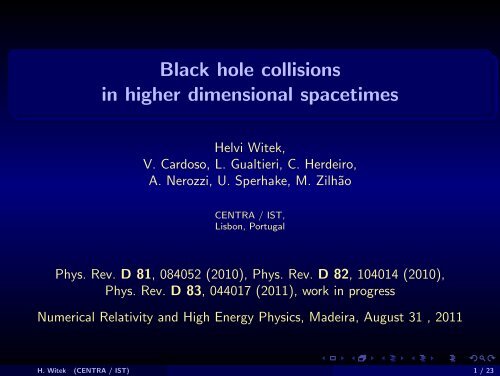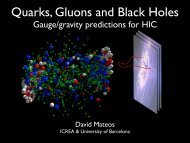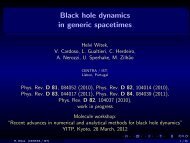in higher dimensional spacetimes
Black hole collisions in higher dimensional spacetimes
Black hole collisions in higher dimensional spacetimes
- No tags were found...
Create successful ePaper yourself
Turn your PDF publications into a flip-book with our unique Google optimized e-Paper software.
Black hole collisions<strong>in</strong> <strong>higher</strong> <strong>dimensional</strong> <strong>spacetimes</strong>Helvi Witek,V. Cardoso, L. Gualtieri, C. Herdeiro,A. Nerozzi, U. Sperhake, M. ZilhãoCENTRA / IST,Lisbon, PortugalPhys. Rev. D 81, 084052 (2010), Phys. Rev. D 82, 104014 (2010),Phys. Rev. D 83, 044017 (2011), work <strong>in</strong> progressNumerical Relativity and High Energy Physics, Madeira, August 31 , 2011H. Witek (CENTRA / IST) 1 / 23
Outl<strong>in</strong>e1 Motivation2 Numerical Relativity <strong>in</strong> D Dimensions3 Numerical Results4 Conclusions and OutlookH. Witek (CENTRA / IST) 2 / 23
High Energy Collision of Particlesabove the Planck scale:gravity is dom<strong>in</strong>ant <strong>in</strong>teraction⇒ classical descriptionConsider particle collsions with E = 2γm 0 c 2 > M PlHoop - Conjecture (Thorne ’72)⇒ black hole formation, if circumference of particle < 2πr SCollisions of shock waves (Penrose ’74, Eardley & Gidd<strong>in</strong>gs ’02)⇒ black hole formation if b ≤ r Snumerical evidence <strong>in</strong> ultra relativistic collision of boson stars(Choptuik & Pretorius ’10)⇒ black hole formation if boost γ c ≥ 2.9⇒ black hole formation <strong>in</strong> high energy collisions of particlesH. Witek (CENTRA / IST) 3 / 23
TeV gravityTeV gravity scenarios⇒ signatures of black hole production <strong>in</strong> high energy collision of particlesat the Large Hadron Collider<strong>in</strong> Cosmic Rays <strong>in</strong>teractionshttp://lhc.web.cern.ch/lhc/http://www.phy.olemiss.edu/GR/H. Witek (CENTRA / IST) 5 / 23
Life cycle of M<strong>in</strong>i Black Holes1 Formationlower bound on BH mass from area theorem (Yosh<strong>in</strong>o & Nambu ’02)2 Bald<strong>in</strong>g phase: end state is Myers-Perry black hole3 Sp<strong>in</strong>down phase: loss of angular momentum and mass4 Schwarzschild phase: decay via Hawk<strong>in</strong>g radiation5 Planck phase: M ∼ M PlGoal: more precise understand<strong>in</strong>g of black hole formation⇒ compute mass and sp<strong>in</strong> of f<strong>in</strong>al black hole⇒ <strong>in</strong>put to event generators (TRUENOIR, Catfish, BlackMax, Charybdis2)Toy model: black hole collisions <strong>in</strong> <strong>higher</strong> dimensionsH. Witek (CENTRA / IST) 6 / 23
Numerical Relativity<strong>in</strong> D > 4 DimensionsYosh<strong>in</strong>o & Shibata, Phys. Rev. D80, 2009,Shibata & Yosh<strong>in</strong>o, Phys. Rev. D81, 2010Okawa, Nakao & Shibata, Phys. Rev. 83, 2011Lehner & Pretorius, Phys. Rev. Lett. 105, 2010Sork<strong>in</strong> & Choptuik, GRG 42, 2010; Sork<strong>in</strong>, Phys. Rev. D81, 2010Zilhão et al., Phys. Rev. D 81, 2010,Witek et al, Phys. Rev. D82, 2010.H. Witek (CENTRA / IST) 7 / 23
Numerical Relativity <strong>in</strong> D Dimensionsconsider highly symmetric problems<strong>dimensional</strong> reduction by isometry on a (D-4)-spheregeneral metric elementds 2 = g µν dx µ dx ν + λ(x µ )dΩ D−4H. Witek (CENTRA / IST) 8 / 23
Numerical Relativity <strong>in</strong> D DimensionsD <strong>dimensional</strong> vacuum E<strong>in</strong>ste<strong>in</strong> equations G AB = R AB − 1 2 g AB R = 0 imply(4) T µν = D − 416πλ[∇ µ ∂ ν λ − 1∇ µ ∇ µ λ = 2(D − 5) − D − 62λ∂µ λ∂ µ λ2λ ∂ µλ∂ ν λ − (D − 5)g µν + D − 54λ]g µν∂ α λ∂ α λ ,⇒ 4D E<strong>in</strong>ste<strong>in</strong> equations coupled to scalar field⇒ different <strong>higher</strong> dimensions manifest <strong>in</strong> scalar fieldH. Witek (CENTRA / IST) 9 / 23
Formulation of EEs as Cauchy Problem <strong>in</strong> D > 43+1 split of spacetime (4) M = R + (3) Σ (Arnowitt, Deser, Misner ’62)ds 2 = g µν dx µ dx ν = ( −α 2 + β k β k) dt 2 + 2β i dx i dt + γ ij dx i dx j3+1 split of 4D E<strong>in</strong>ste<strong>in</strong> equations with source terms=⇒ Formulation as <strong>in</strong>itial value problem with constra<strong>in</strong>ts (York 1979)Evolution Equations∂ t γ ij = −2αK ij + L β γ ij( )∂ t K ij = −D i D j α + α (3)R ij − 2K il Kj l + KK ij + L β K ij−α D − 4 (D i D j λ − 2K ij K λ − 1 )2λ2λ ∂ iλ∂ j λ∂ t λ = −2αK λ + L β λ∂ t K λ = − 1 (2 ∂l α∂ l λ + α (D − 5) + KK λ + D − 6λK λ2− D − 64λ∂l λ∂ l λ − 1 )2 Dl D l λ + L β K λH. Witek (CENTRA / IST) 10 / 23
Wave Extraction <strong>in</strong> D > 4Generalization of Regge-Wheeler-Zerilli formalism by Kodama & Ishibashi ’03Master functionΦ ,t = (D − 2)r (D−4)/2Energy flux & radiated energy2rF ,t − F r tk 2 − D + 2 + (D−2)(D−1)2, k = l(l + D − 3)r D−3Sr D−3dE ldt = (D − 3)k2 (k 2 − D + 2)(Φ l32π(D − 2),t) 2 , E =∞∑l=2∫ ∞−∞dt dE ldtMomentum flux & recoil velocitydP idt∫= dΩ d 2 ES ∞dtdΩ ni , v recoil =∣∫ ∞−∞dt dPdt∣H. Witek (CENTRA / IST) 11 / 23
Numerical Setupuse Sperhake’s extended Lean code (Sperhake ’07, Zilhão et al ’10)3+1 E<strong>in</strong>ste<strong>in</strong> equations with scalar fieldBaumgarte-Shapiro-Shibata-Nakamura formulation with mov<strong>in</strong>g punctureapproachdynamical variables: χ, ˜γ ij , K, à ij , ˜Γ i , ζ, K ζmodified puncture gaugeBrill-L<strong>in</strong>dquist type <strong>in</strong>itial data∂ tα = β k ∂ k α − 2α(η K K + η Kζ K ζ )∂ tβ i = β k ∂ k β i − η β β i + η Γ˜Γ i D − 4− η λ ˜γ ij ∂ j ζ2ζψ = 1 + r D−3 D−3S,1/4r1 + r D−3S,2measure lengths <strong>in</strong> terms of r S withr D−3 16πS=M(D − 2)A SD−2D−3/4r2H. Witek (CENTRA / IST) 12 / 23
Unequal mass head-on<strong>in</strong> D = 5 dimensionsPhys. Rev. D 83, 2011H. Witek (CENTRA / IST) 13 / 23
Unequal mass head-on <strong>in</strong> D = 5Modes of Φ ,tl=3 1/2 l=2 1/2Φ Φ ,t / rS ,t / rS0.0400.00500.0009Φ ,tl=4 / rS1/20q = 1q = 1:2q = 1:4consider mass ratiosq = r D−3 D−3S,1/rS,2 = 1, 1 2 , 1 3 , 1 4-10 0 10 20 30∆t / r Sq E/M(%) E l=2 (%) E l=3 (%) E l=4 (%)1/1 0.089 99.9 0.0 0.11/2 0.073 97.7 2.2 0.11/3 0.054 94.8 4.8 0.41/4 0.040 92.4 7.0 0.6H. Witek (CENTRA / IST) 14 / 23
Unequal mass head-on <strong>in</strong> D = 5 - radiated energyE/M ∼ η 2(M.Lemos ’10, MSc thesis,http://blackholes.ist.utl.pt/ )fitt<strong>in</strong>g functionEMη 2 = 0.0164 − 0.0336η2 ,with<strong>in</strong> < 1% agreement withpo<strong>in</strong>t particle calculation(Berti et al, 2010)H. Witek (CENTRA / IST) 15 / 23
Equal mass head-on<strong>in</strong> D = 4, 5, 6 dimensionsPhys. Rev. D 82, 104014 (2010)work <strong>in</strong> progressH. Witek (CENTRA / IST) 16 / 23
Equal mass head-on <strong>in</strong> D = 6 (prelim<strong>in</strong>ary results)The good news is: We can do it !!!Key (technical) issues:modification of gaugeconditionsmodification of formulation<strong>in</strong>crease <strong>in</strong> E/M with D⇒ qualitative agreement withPP calculations(Berti et al, 2010)1 prelim<strong>in</strong>aryD r S ω(l = 2) E/M(%)4 0.7473 − i 0.1779 0.0555 0.9477 − i 0.2561 0.0896 1.140 − i 0.304 0.097 1H. Witek (CENTRA / IST) 17 / 23
Head-on collisionsof boosted black holesZilhão et al (work <strong>in</strong> progress)H. Witek (CENTRA / IST) 18 / 23
Initial data for boosted BHs <strong>in</strong> D > 4 (Zilhão et al)construct <strong>in</strong>itial data by solv<strong>in</strong>g the constra<strong>in</strong>tsD-<strong>dimensional</strong> metric elementds 2 = −α 2 dt 2 + ¯γ ab(dx a + β a dt )( dx b + β b dt )assumption: ¯γ ab = ψ 4D−3 δab , ¯K = 0 , ¯K ab = ψ −2  abconstra<strong>in</strong>t equations∂ a  ab = 0 , ˆ△ψ + D − 3 3D−5ψ− D−3  ab  ab = 0 , with ˆ△ ≡ ∂ a ∂ a4(D − 2)analytic ansatz for  ab → generalization of Bowen-York type <strong>in</strong>itial dataelliptic equation for ψ → puncture method (Brandt & Brügmann ’97)ψ =1 +N∑i=1µ (i)4r D−3 + u(i)⇒ Hamiltonian constra<strong>in</strong>t becomesˆ△u + D − 34(D − 2)Âab  ab ψ − 3D−5D−3 = 0H. Witek (CENTRA / IST) 19 / 23
Initial data for boosted BHs <strong>in</strong> D > 4 - Resultsextension of the TwoPunctures pseudo-spectral solver(M. Ansorg et al, ’04)<strong>in</strong>itial data for punctures at z/r S = ±30.185 with P/r D−3S= 0.8Hamiltonian constra<strong>in</strong>tConvergence analysis|H|10 -110 -310 -510 -710 -910 -1110 -1310 -1510 -1710 -1910 -21P/r D 3S =0.8, b/r S =30.185, n =30010 1 10 2z/r SD =4D =5D =6D =7n,300 (u)10 4 D=4D=510 2D=6D=710 010 -210 -410 -610 -810 -10 0 50 100 150 200 250 300nH. Witek (CENTRA / IST) 20 / 23
Head-on of boosted BHs <strong>in</strong> D = 5(prelim<strong>in</strong>ary results)evolution of puncture with z/r S = ±30.185 with P/r D−3S= 0.4l = 2 mode of Φ ,t0.040.02Φ ,tl=2 / rS1/20-0.02-0.040 100 200 300t / r_SH. Witek (CENTRA / IST) 21 / 23
Thank you!http://blackholes.ist.utl.ptH. Witek (CENTRA / IST) 23 / 23




